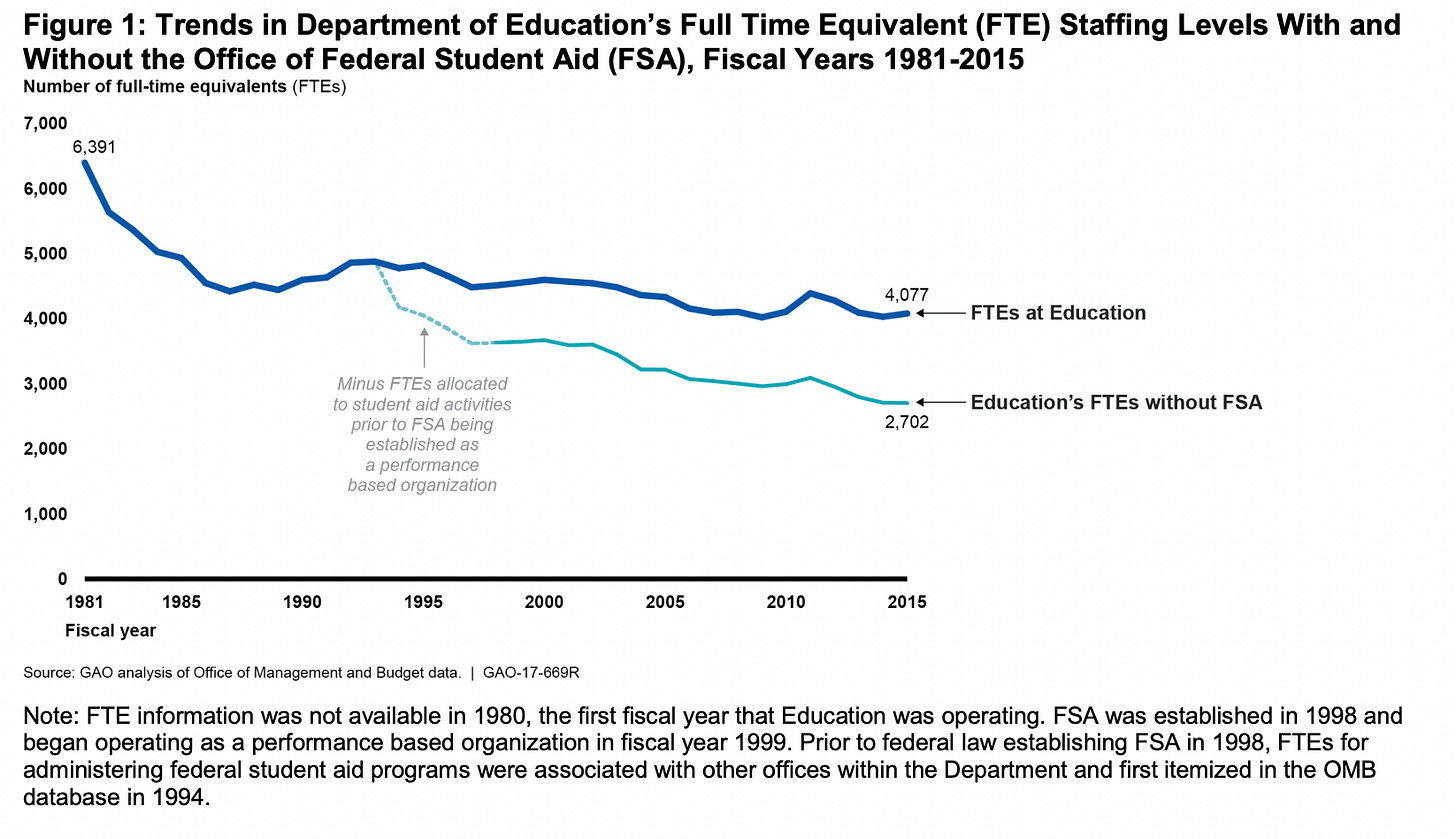Make the Department of Education Great Again
It's missing deadlines, resolving fewer cases, reducing customer service, and cutting key research and data collection efforts
Did you know that the U.S. Department of Education (USED) used to be bigger than it is today, and much larger than it was last year?
The graph below comes from a 2017 GAO report that looked into staffing and contracting levels at the Department. Their data run from 1981 through 2015. As you can see in the chart, the Department has shrunk considerably over time, from a high of 6,391 FTEs in 1981 down to 4,077 in 2015.
If you were to update the graph through today, you would see that staffing levels continued to fall during the first Trump Administration, to a new low, before ramping back up slightly during the Biden Administration. That increase was at least in part due to the administration and oversight of huge infusions of one-time COVID relief funds.
So, are fewer Department of Education employees needed because they have less work to do? No, they’re actually overseeing a lot more money. As Ben Miller pointed out in a piece back in March, the Department of Education was already the smallest Cabinet-level agency in terms of staffing, even before the Trump Administration took office, and yet it oversaw the fourth-largest annual appropriation amount. (Miller’s figures excluded the $1.6 trillion federal student loan portfolio managed by the agency, which would also make it the fifth-largest bank in the country.) In other words, the Department of Education is responsible for sending a lot of money out the door without a whole lot of staff members to oversee it.
Now look what’s happened since then. The table below comes from the President’s most recent FY 2026 budget request. As you can see at the end of the table, President Trump is proposing to significantly reduce staffing levels going forward.
Could the Department do a better job? Yes, it probably could. I say that even as someone who worked there during the Obama Administration.
But will the Department do a better job if it has fewer workers? That I highly doubt. In fact, after eliminating nearly 50% of its staff, the Trump Administration is already under-performing on several fronts:
It has resolved 40% fewer civil rights violations, despite a 9% increase in complaints;
It had to scale back on NAEP testing, cutting planned tests measuring long-term trends in reading and math as well as tests of science, writing, and history;
It has missed reporting deadlines and has been releasing extremely abridged versions of key statistical reports; and
It is providing less customer service and answering fewer questions from college and state and district leaders.
My examples are easily quantifiable reductions in service quality, but it’s impossible to know yet what else is missing. Writing in The Atlantic, Kevin Carey warned that the Department has terminated almost all the people whose job it was to stop waste, fraud, and abuse in higher education. These are problems we won’t know about until it’s too late. And at The 74, Kevin Mahnken highlighted a number of important research projects and statistical collections that the Administration eliminated, including long-term tracking projects related to students who receive federal financial aid and the progress of the kindergarten class of 2022-23. These are stories we’ll never know about because the data are no longer being collected.
Now, I’m not one to blindly defend the Department of Education. But what I do care about are the functions of the U.S. Department of Education and the people who are carrying out those roles.
And so, apparently, does the U.S. Senate Appropriations Committee. In a strong rebuke of the President’s proposed plans for the Department, it voted 26-3 to preserve and even expand funding levels and restore the Department to its prior staffing levels. At EdWeek, Mark Lieberman wrote this blunt synopsis of the bill:
It maintains all existing federal K-12 grant programs as separate funding streams with roughly level year-over-year funding, including for teacher training, literacy instruction, rural schools, and services for homeless students and English learners.
It extends current-year funding and staffing levels for key Education Department offices the Trump administration has dismantled in recent months, including the office for civil rights ($140 million), the Institute of Education Sciences ($793 million), and comprehensive centers that provide technical assistance to states and districts ($50 million).
It also includes language instructing the Department to send fund to schools on time, and to hold staffing at levels necessary to maintain services. This is just one committee vote, and we should heed Andy Rotherham’s caution not to over-read the situation, but it was a signal from senators in both parties that they value the work of the Department and do not want it “dismantled.”
The Trump Administration has already made the Department of Education smaller. What I want to see is a plan to make the Department of Education better.





Very nice. Great title. Tell us when it hits the AldeMerch Shop.